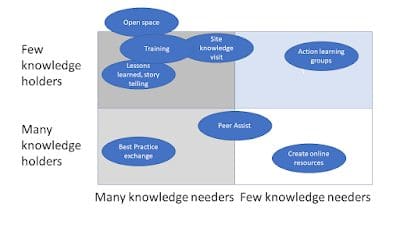
Favorite The demographics of your organisation determine the distribution of knowledge, and therefore the details of the Knowledge Management Framework you need to deploy Here’s another factor that can affect the way you address KM in an organisation; the demographics of the workforce. Because the demographics are is linked to
Read More
 Shared by Nick Milton September 20, 2022
Shared by Nick Milton September 20, 2022

Favorite There is a clear view than knowledge lies in the “walls” and the “hallways” between the “rooms” of an organisation. Here are some of the implications of this view for Knowledge Management. Image from wikimedia commons This blog post was inspired by a post from Nancy Dixon entitled Where Is
Read More
 Shared by Nick Milton April 4, 2022
Shared by Nick Milton April 4, 2022

Favorite I read this story on Linked-In with real enjoyment, and have the author’s permission to share it with you. This is the image Tabarak used to illustrate her story It’s an inspiring story of how anyone in an organisation, even those very new in their post, may have valuable
Read More
 Shared by Nick Milton September 22, 2021
Shared by Nick Milton September 22, 2021

Favorite We all suffer from bandwidth issues in KM – generally due to the deluge of information. Here’s a good principle from the military for dealing with these issues. Information overload by SparkCBC on Flickr The phrase – “Smart push, warrior pull” (described here). is a very useful military principle for
Read More
 Shared by Nick Milton September 16, 2020
Shared by Nick Milton September 16, 2020

Favorite The Curse of Knowledge is a real problem when it comes to knowledge sharing; trying to transfer knowledge to the Unknown User. It’s also one of the reasons why lesson management systems are full of mushy motherhoods and useless bullet points. Curses!!! Foiled Again.uploaded to Flickr by Joe Shlabotnik The
Read More
 Shared by Nick Milton August 19, 2020
Shared by Nick Milton August 19, 2020

Favorite How do Japanese organisations approach best pratice sharing? Let’s look at Yokoten Workers exchanging knowledge (genchi gembutsu) Japan, exemplified by Toyota, has developed its own flavour of Knowledge Management. Together with a local focus on knowledge development (Kaizen), knowledge documentation (A3) and the behaviours of Hansei we can add
Read More
 Shared by Nick Milton August 13, 2020
Shared by Nick Milton August 13, 2020

Favorite How do Japanese organisations approach best pratice sharing? Let’s look at Yokoten Workers exchanging knowledge (genchi gembutsu) Japan, exemplified by Toyota, has developed its own flavour of Knowledge Management. Together with a local focus on knowledge development (Kaizen), knowledge documentation (A3) and the behaviours of Hansei we can add
Read More
 Shared by Nick Milton August 13, 2020
Shared by Nick Milton August 13, 2020

Favorite Here is another excellent article from Tom Davenport, one of the clearest writers on the topic of Knowledge Management, making the case for a structured “just-in-time” approach to the supply of knowledge. Tom starts his article as follows: In the half-century since Peter Drucker coined the term “knowledge workers,”
Read More
 Shared by Nick Milton July 23, 2020
Shared by Nick Milton July 23, 2020

Favorite Here is a very interesting article from G2 about how they finally made knowledge sharing work, after failing twice. The article, by Deirdre O’Donoghue, is a very interesting read. They tried to introduce structured knowledge sharing three times, and only succeeded at the third attempt. What was different about
Read More
 Shared by Nick Milton July 1, 2020
Shared by Nick Milton July 1, 2020

Favorite You want to plan a face to face event for your Community of Practice in order to transfer knowledge, but which event style do you select? This is a discussion I have been having recently, and it struck me that this might be a useful blog post. Now there
Read More
 Shared by Nick Milton March 2, 2020
Shared by Nick Milton March 2, 2020
![]() Shared by Nick Milton September 20, 2022
Shared by Nick Milton September 20, 2022









